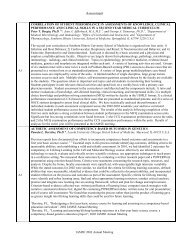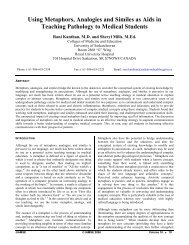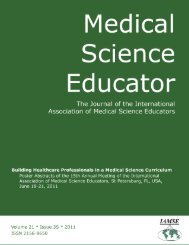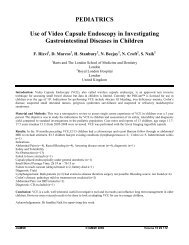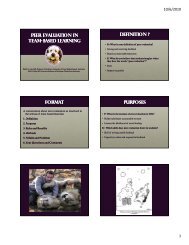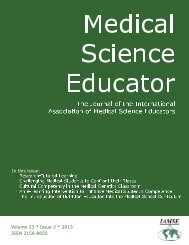Click here to view complete journal in pdf-format - IAMSE
Click here to view complete journal in pdf-format - IAMSE
Click here to view complete journal in pdf-format - IAMSE
You also want an ePaper? Increase the reach of your titles
YUMPU automatically turns print PDFs into web optimized ePapers that Google loves.
CONCLUSIONS<br />
Requir<strong>in</strong>g students <strong>to</strong> actively <strong>in</strong>teract with the<br />
virtual slides is an effective use of virtual slides.<br />
Instructional Methods Abstract ID: 184 eDemo<br />
UTILIZATION OF A MULTI-DIMENSIONAL<br />
MODEL TO TEACH MICROBIOLOGY IN AN<br />
ORGAN SYSTEMS COURSE<br />
M.M. Harriott, Oakland University William<br />
Beaumont School of Medic<strong>in</strong>e, USA<br />
PURPOSE<br />
Microbiology is often difficult for medical students<br />
<strong>to</strong> master. Students often memorize rather than<br />
analyze, impair<strong>in</strong>g retention of knowledge. Didactic<br />
lectures may not be the most effective method of<br />
teach<strong>in</strong>g microbiology. This study was designed <strong>to</strong><br />
develop an organ system based microbiology unit <strong>to</strong><br />
promote mean<strong>in</strong>gful learn<strong>in</strong>g by <strong>in</strong>tegrat<strong>in</strong>g: 1)<br />
<strong>in</strong>dependent study 2) didactic lecture 3) active<br />
learn<strong>in</strong>g.<br />
METHODS<br />
A microbiology unit for a 1st year neuroscience<br />
course was developed <strong>in</strong>corporat<strong>in</strong>g the above<br />
components. For the <strong>in</strong>dependent study, a guide<br />
was distributed 2-weeks prior <strong>to</strong> the lecture,<br />
consist<strong>in</strong>g of tables, pictures and short cases<br />
cover<strong>in</strong>g major CNS pathogens. The didactic lecture<br />
emphasized pathogenesis, epidemiology and<br />
microbiologic diagnosis of CNS <strong>in</strong>fections. The<br />
active learn<strong>in</strong>g consisted of a “Who Wants <strong>to</strong> Be a<br />
Millionaire” type game. Students were divided <strong>in</strong><strong>to</strong><br />
groups, and each received identical sets of case<br />
studies. After <strong>in</strong>tra-group discussions, teams<br />
responded <strong>to</strong> test questions of vary<strong>in</strong>g value us<strong>in</strong>g<br />
an audience response system. Higher perform<strong>in</strong>g<br />
teams were awarded prizes.<br />
RESULTS<br />
Instruc<strong>to</strong>r preparation was more <strong>in</strong>tensive than for<br />
a traditional lecture. Prelim<strong>in</strong>ary data show most<br />
students <strong>complete</strong>d the <strong>in</strong>dependent study, and<br />
both the study guide and <strong>in</strong>teractive session were<br />
useful for exam preparation. Future studies will<br />
exam<strong>in</strong>e student feedback and performance on<br />
exams and boards <strong>to</strong> assess the utility of this multidimensional<br />
unit.<br />
CONCLUSIONS<br />
Incorporat<strong>in</strong>g <strong>in</strong>dependent study, didactic lecture<br />
and active learn<strong>in</strong>g accommodates multiple learn<strong>in</strong>g<br />
styles. Group activities promote critical th<strong>in</strong>k<strong>in</strong>g<br />
skills and collaboration <strong>in</strong> medic<strong>in</strong>e. Lastly,<br />
<strong>in</strong>corporat<strong>in</strong>g microbiology <strong>in</strong><strong>to</strong> an organ systems<br />
course allows students <strong>to</strong> contextualize<br />
microbiology.<br />
Instructional Methods Abstract ID: 185 Award<br />
Nom<strong>in</strong>ee<br />
DEMISE OF THE MEDICAL<br />
MICROBIOLOGY TEACHING<br />
LABORATORY?<br />
Janet Hear<strong>in</strong>g and Wei-Hs<strong>in</strong> Lu, S<strong>to</strong>ny Brook<br />
University, S<strong>to</strong>ny Brook, NY, USA<br />
PURPOSE<br />
The “wet” microbiology lab has long been an<br />
important element of undergraduate medical<br />
microbiology courses. Despite overwhelm<strong>in</strong>g<br />
support for active learn<strong>in</strong>g strategies among<br />
medical educa<strong>to</strong>rs, t<strong>here</strong> is concern that many<br />
medical schools have elim<strong>in</strong>ated their wet<br />
microbiology lab. This study was conducted <strong>to</strong><br />
determ<strong>in</strong>e the way <strong>in</strong> which medical students are<br />
taught labora<strong>to</strong>ry medic<strong>in</strong>e <strong>in</strong> microbiology and <strong>to</strong><br />
document curricular content and trends <strong>in</strong><br />
<strong>in</strong>structional methods.<br />
METHODS<br />
Precl<strong>in</strong>ical course direc<strong>to</strong>rs responsible for teach<strong>in</strong>g<br />
microbiology at 131 medical and osteopathic<br />
medical schools <strong>in</strong> the U.S. and Canada were <strong>in</strong>vited<br />
<strong>to</strong> participate <strong>in</strong> this study. Seventy course direc<strong>to</strong>rs<br />
(53% response rate) <strong>complete</strong>d an onl<strong>in</strong>e survey.<br />
RESULTS<br />
S<strong>in</strong>ce 2002, the number of “wet” microbiology lab<br />
hours decreased at 43% of respond<strong>in</strong>g schools.<br />
Thirty six percent of the respondents’ courses do not<br />
<strong>in</strong>clude a “wet” microbiology lab and over half of<br />
these schools elim<strong>in</strong>ated their lab <strong>in</strong> the past ten<br />
years. Reasons for a reduction or elim<strong>in</strong>ation of the<br />
teach<strong>in</strong>g lab were limited resources (money,<br />
<strong>in</strong>structional staff, facilities; n=15), reduced<br />
teach<strong>in</strong>g hours (n=10), curricular changes (n=9),<br />
and irrelevance of hav<strong>in</strong>g students learn <strong>to</strong> perform<br />
diagnostic work (n=4). T<strong>here</strong> was a negative<br />
correlation between class size and the number of<br />
hours of lab <strong>in</strong>struction although not significant.<br />
Computer-assisted <strong>in</strong>struction is used <strong>to</strong> teach<br />
labora<strong>to</strong>ry medic<strong>in</strong>e <strong>in</strong> microbiology at 39% of the<br />
schools and is more likely <strong>to</strong> be used with a teach<strong>in</strong>g<br />
lab than without. Additional descriptive data will be<br />
presented that <strong>in</strong>cludes the types of diagnostic tests<br />
performed <strong>in</strong> the teach<strong>in</strong>g labora<strong>to</strong>ries.<br />
CONCLUSIONS<br />
The way <strong>in</strong> which labora<strong>to</strong>ry medic<strong>in</strong>e <strong>in</strong><br />
microbiology is be<strong>in</strong>g taught <strong>to</strong> precl<strong>in</strong>ical medical<br />
students has undergone significant change <strong>in</strong> the<br />
Medical Science Educa<strong>to</strong>r © <strong>IAMSE</strong> 2012 Volume 22(4S) 310



